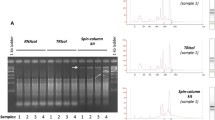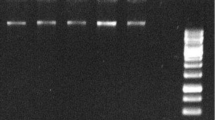Abstract
The isolation of high-quality RNA from various tissues (leaves, pedicels, glandular trichomes) of garden geranium (Pelargonium xhortorum) using various published methods is difficult due to numerous oxidizing compounds. A new RNA extraction method was developed through the combination and modification of two separate procedures (Rochester et al., 1986; Manning 1991). In addition to geranium tissues, this method is successful when used with other recalcitrant tissues such as mature needles of white pine (Pinus strobus) and mature leaves of poinsettia (Euphorbia pulcherrima). RNA quality was judged by spectrophotometric readings, denaturing agarose gels, and successful reverse transcription.
Similar content being viewed by others
Abbreviations
- CTAB:
-
cetyltrimethylammonium bromide
- EGTA:
-
ethylene glycol-bis (β-aminoethyl ether) N, N, N-, N-tetraacetic acid
- PVPP:
-
polyvinylpolypyrrolidone
- 2-BE:
-
ethylene glycol monobutylether
- DEPC:
-
diethylpyrocarbonate
References
Baker, S.S., C.L. Rugh, and J.C. Kamalay. 1990. RNA and DNA isolation from recalcitrant plant tissues. Bio Techniques 9: 268–272.
Hesk, D., R. Craig, and R.O. Mumma. 1992. Comparison of anacardic acid biosynthetic capability between insect-resistant and-susceptible geraniums. J. Chem. Ecol. 18:1349–1363.
Hughes, D.W., and G. Galau. 1988. Preparation of RNA from cotton leaves and pollen. Plant Mol. Biol. Reptr. 6: 253–257.
Levi, A., G.A. Galau, and H.Y. Wetzstein. 1992. A rapid procedure for the isolation of RNA from high-phenolic-containing tissues of pecan. HortScience 27: 1316–1318.
Logemann, J., J. Schell, and L. Willmitzer. 1987. Improved method for the isolation of RNA from plant tissues. Anal. Biochem. 163: 16–20.
Lopez-Gomez, R., and M.A. Gomez-Lim. 1992. A method for extraction intact RNA from fruits rich in polysaccharides using ripe mango mesocarp. HortScience 27: 440–442.
Manning, K.. 1990. Isolation of nucleic acids from plants by differential solvent precipitation. Anal. Biochem. 195:45–50.
Newbury, H.J., and J.V. Possingham. 1977. Factors affecting the extraction of intact ribonucleic acid from plant tissues containing interfering phenolic compounds. Plant Physiol. 60: 543–547.
Rochester, D.E., J.A. Winer, and D.M. Shah. 1986. The structure and expression of maize genes encoding the major heat shock protein, hsp70. EMBO 5: 451–458.
Su, X., and A. Gibor. 1988. A method for RNA isolation from marine macro-algae. Anal. Biochem 174:650–657.
Walters, D.S., R. Craig, and R.O. Mumma. 1990. Fatty acid incorporation in the biosynthesis of anacardic acids of geraniums. Phytochemistry 29:1815–1822.
Yerger, E.H., R.A. Grazzini, D. Hesk, D.L. Cox-Foster, R. Craig and R.O. Mumma 1992. A rapid method for isolation glandular trichomes. Plant Physiol. 99: 1–7.
Author information
Authors and Affiliations
Rights and permissions
About this article
Cite this article
Schultz, D.J., Craig, R., Cox-Foster, D.L. et al. RNA isolation from recalcitrant plant tissue. Plant Mol Biol Rep 12, 310–316 (1994). https://doi.org/10.1007/BF02669273
Issue Date:
DOI: https://doi.org/10.1007/BF02669273




